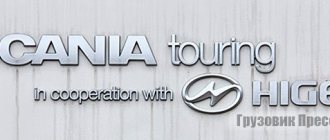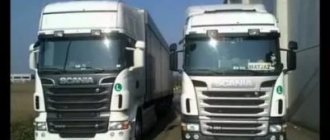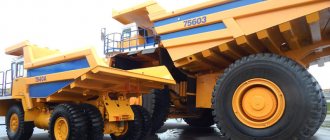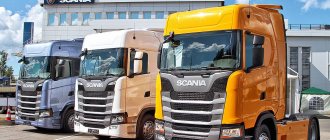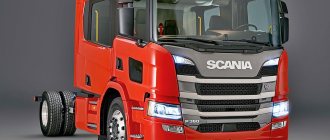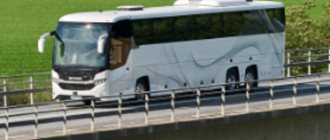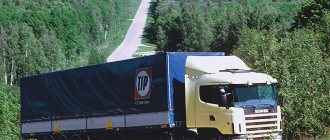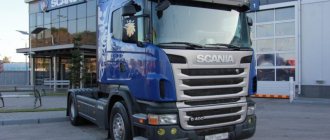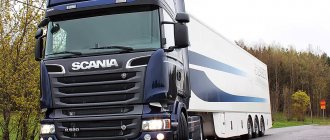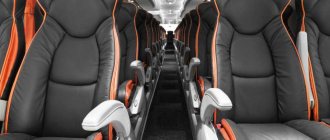V8 engines
Incredible level of availability. Efficiency. Reliability. Power.
Meeting your obligations and schedule is the number one requirement in the transportation industry. With the reliability of Scania V8 trucks, your business will only prosper.
V8
- New V8 engines and transmissions provide fuel savings of up to 6%;
- A range of engines of different power - 530, 590, 660 and 770 hp. With.;
- Low internal friction, updated turbocharger and intelligent auxiliary devices;
- Updated exhaust gas neutralization system;
- Longer and heavier road trains provide increased transport efficiency with lower CO2 emissions, both with and without biodiesel.
The new Scania V8 engines not only provide record power, but also significantly improved fuel efficiency. Total savings can be up to 6% when installing a new G33 transmission.
The most impressive engine of the new generation V8 is the top version with 770 hp. with a torque of 3700 N/m. The most powerful engine for trucks today.
SCANIA V8 AT THE PEAK OF DEVELOPMENT
- Reduced internal friction;
- New exhaust gas purification system with two-stage AdBlue injection;
- New fuel pump with active inlet metering;
- Completely new hardware and software for engine control;
- Increased compression ratio and maximum cylinder pressure;
- Switchable associated equipment, such as a compressed air compressor;
- Fixed geometry turbocharger with ball bearings in the 770 hp engine.
Scania is constantly working to improve V8 engines and is now introducing four even more fuel-efficient versions to tackle the toughest transport challenges. All these significant improvements are the result of the passion, experience, competence and ingenious solutions of Scania engineers.
Thanks to the two-stage AdBlue injection, where the first dose is injected into the very hot flow immediately after the exhaust brake, evaporation is improved during low-load operation. This means that the new Scania V8 engines meet the requirements of the Euro 6 environmental standard, which will come into force in 2021.
The EMS engine management system interacts with the AMS, the exhaust gas aftertreatment system. Both are important for compliance with current and future Euro 6 regulations regarding NOx and soot particles. (Not only for a new truck, but also for used ones, the requirements of the European environmental standard must be met for at least seven years or 700 thousand km).
Scania has come up with a new solution: the AdBlue additive is actually injected twice: the first time directly after the engine retarder, the second time, as before, in the muffler itself. With additional dosing, AdBlue evaporation improves during low-load driving, since the temperature near the exhaust manifold is higher. In addition, the neutralization strategy is improved, which improves fuel efficiency.
SCANIA V8 AT THE PEAK OF DEVELOPMENT
The updated V8 engine range features a new high-pressure fuel pump with individual pump element management (AIM, active inlet metering). For increased uptime and improved performance, overall pressure and intake control has been improved with an advanced diagnostic system. The new pump is also optimized to minimize engine oil consumption. In addition, the compression ratio and maximum cylinder pressure have been increased to further improve combustion efficiency and improve fuel efficiency.
One of the most important challenges in designing high-performance engines is reducing internal friction. By reducing internal losses, significant results were achieved. One alternative is to use more efficient modern lower viscosity oils with properties that were not possible just 10-15 years ago. But the improvements achieved by switching to long-life oil in recent years are not enough. The engine itself must also be designed to accommodate the new capabilities.
To increase pressure and power output, several engine components, including gears, pistons, rings, cylinder heads and valves, need to be improved and strengthened.
The new king of the roads
The most impressive member of the V8 family is the new DC16 123. With 770 hp, it replaces the previous flagship 730 hp engine. The difference between them is that the 770 shares the same updated platform as the rest of the new range, delivering the consistently high level of reliability for which all Scania V8s are renowned.
The engine features Selective Catalytic Reduction (SCR), a robust fixed-geometry turbocharger, and the same single-row exhaust manifold as the other three V8 engines.
The powerful DC16 123 develops 770 hp. With. Featuring larger injectors and a ball-bearing fixed geometry turbocharger (FGT), this ensures quick response to changing conditions and improved combustion.
The removal and simplification of some heavy components ensured that the engine's weight was reduced by up to 75 kg compared to its predecessor. Another innovation is that, to improve throttle response, the 770 hp engine. Features a unique fixed geometry turbocharger with ball bearings rather than conventional plain bearings.
The new integrated exhaust manifolds are not only much lighter and more efficient, they create a distinctive engine sound - a special rumble that many Scania customers and V8 fans appreciate, it does not produce more noise, it is rather the result of the way the exhaust gases collide with the cylinders when firing. the course of their movement inside the collector.
V8 TRANSMISSION
NEW RANGE OF SCANIA TRANSMISSIONS – HIGH-TECH SOLUTIONS
Scania has released a new range of gearboxes that will gradually replace all existing units with Scania Opticruise. The first member of the line, the G33CM gearbox will be available in combination with the updated Scania V8 engines, as well as 13-liter engines with 500 and 540 hp. More than 400 million euros have been invested in the development.
- A series of robotic gearboxes designed specifically to improve dynamics and environmental friendliness;
- Due to the wide range of gear ratios, noise levels and fuel consumption are reduced by 1%;
- Lighter and improved gear shifting and the ability to work with an engine with a torque of up to 3700 N/m;
- All-aluminum body, reduced internal friction losses and economical gear ratios;
- It is possible to equip it with a retarder with improved characteristics and intelligent power take-offs in several versions;
- The technology ensures that ICE solutions continue to support the concept of sustainable transport.
The new gearboxes are designed to improve the efficiency and environmental friendliness of road transport over the next decade. A key feature is a wider range of gear ratios. This makes them ideal for our low-revving engines, which feature smooth, fast shifting and reduced fuel consumption.
The new V8 engine, together with the new Scania Opticruise gearbox and a rear final drive adapted for direct-drive driving (gear 12), can achieve fuel savings of up to six percent.
For example, on a truck with a capacity of 590 hp. With. On long hauls in hilly terrain, fuel savings in this range are possible, with engine savings of two percent, transmission savings of three percent, and rear axle savings of one percent*.
A wide range of gear ratios allows you to optimize the rear axle gear ratio to reduce engine speed at route speed without reducing the ease of starting. The result is a highly efficient powertrain for a profitable and environmentally friendly business.
* Comparison of 580 HP transmissions. s./GRSO/3.08 and 590 l. pp./G33CM/2.59
Dump trucks, tractors 6x6 Scania YAKUTIA KHABAROVSK MAGADAN BLAGOVESHCHENSK
Scania engines
Scania engines are produced in a wide range - 9, 11, 12 and 13-liter in-line engines, 16-liter V-eights. There are more than 20 engines in total with a power range from 230 to 730 horsepower and torque from 1050 to 3500 N.m.
Scania engine 9-liter 230-260-300 hp.
The simplest and most inexpensive Scania engines were installed on the first Griffins - 9-liter DSC9 inline sixes with 310 hp. and torque 1355 N.m. Moreover, there were also weaker versions - 230 hp, which were installed on Griffin tractors with spring rear suspension, but few of these cars were sold.
Scania DSC9 engines had mechanical fuel injection pumps and two-valve heads, with turbocharging and intercooler, but their potential was not enough to further increase power and achieve standards above Euro-2.
SCANIA has developed a new family of engines, unified by a piston group with a diameter of 127 mm, four-valve separate heads and electronically controlled unit injectors. Over time, all Scania diesel engines, from the 9-liter inline-five to the flagship 16-liter V-8, received a modular design.
No other manufacturer has such unification of parts. Unification reduces the number of spare parts, which means problems with the availability and supply of spare parts are reduced, and the cost of engines is reduced.
Since 2003, Scania begins to install on Griffin, in addition to 9-liter engines, new 11-liter diesel engines of the DC11 family of Euro-3 level, with a power of 340 and 380 hp. Moreover, for Griffin only two initial power settings were used, which significantly increased the reliability and durability of the engines. In addition to these two models, there were also engines with 420 hp, which began to be used later.
Scania engine 11-liter 340-380 hp.
Exotic for Russia was the version of the Scania engine with a turbo compound, which developed 470 hp. Another turbine was installed in its design, which additionally transmitted torque to the crankshaft through a viscous coupling and gearbox.
By 2007, SCANIA completed updating the range of manufactured engines with a unified piston and heads. A family of Scania DC12 engines appeared, which differed from 11-liter engines in increased piston stroke and, accordingly, volume. At the same time, the crank radius of the crankshafts and the length of the connecting rods are, of course, different. All these new engines were also installed on Griffin project tractors - their power range is from 340 to 470 hp. and torque from 1700 to 2200 N.m.
Structurally, all Scania in-line engines are similar - they have a cast-iron block, wet liners, a camshaft in the block, rocker arms with rods, and a timing drive on the flywheel side. Only the modern 9-liter “five” has two more balancing shafts; it is clear that in-line “sixes” have no need for them.
In addition to the most common aluminum pistons, Scania also has composite pistons, with a heat-resistant steel bottom and an aluminum skirt. One of the advantages of separate heads is reliability, because it cannot immediately break through all six head gaskets, probably only one. And it costs significantly less than a single gasket for a common head. The disadvantage is that it is difficult to place an additional valve and control mechanism for the engine compression brake.
Another family of Scania diesel engines is the 12.7 liter DC13 “six”, and now they are also produced in Euro 6 version. One DC13 109 with 440 hp, the other DC12 110 with 480 hp. An important nuance is that the power and torque of Euro-6 engines remained at the same level as that of Euro-5 engines.
According to SCANIA designers, the power range is 440-480 hp. most in demand in long-haul transportation and on construction trucks, up to four-axle vehicles. The new engines belong to the family of diesel engines with a cylinder diameter increased from 127 to 130 mm, with dimensions of 130x160 mm. The cast iron cylinder block of the Scania DC13 engine is designed for combustion chamber pressures of up to 200 bar. To give additional rigidity to the block, as well as to reduce noise and vibration, the housing of the main bearing caps is made in a single casting. This design solution is also called a “frame”.
The cooling system fan on all SCANIA engine models is equipped with a reliable poly-V belt and an electromagnetic drive clutch controlled by an electronic unit. The lubrication system has a water-oil heat exchanger; it maintains the optimal oil temperature.
If Scania diesel engines of the Euro-2 level had mechanical injection pumps and this was quite enough, then to achieve the modern level of environmental cleanliness, Scania engines have long been equipped with a fuel system with electronically controlled pump injectors. And the newest engine models use the Common Rail system. Depending on the version, the injection pressure reaches 1500 bar or higher. Scania developed some fuel systems together with the American engine manufacturer Cummins - the Scania XPI common rail system. High pressure, cyclic supply accuracy, and precision of electronically controlled fuel systems place increased demands on the purification of diesel fuel from impurities. Scania has also provided for this and added an additional electrically heated sediment filter to the fuel system.
EGR Scania
An important point for Russian carriers is that Scania offers engines of Euro-4 and Euro-5 levels, both with injection of an aqueous urea solution and with exhaust gas recirculation, when there is no need to spend money on purchasing AdBlue. On most Euro 3 and Euro 4 engines, Scania has given preference to exhaust gas recirculation, that is, the EGR system. Thus, several years ago, Scania attracted an additional number of buyers in Western Europe where urea was in short supply, much like in Russia now. However, it was not possible to completely abandon AdBlue. In 2005, Scania used SCR technology on V8 engines, and on Euro 6 engines they had to combine EGR with urea neutralization, and supplement these two previously opposing technologies with a particulate filter.
Operating Scania engines in winter
Russian winter is a severe test even for Swedish Scania cars. The first “Gryphons” were equipped with 220-volt electric engine heating, but even now there are no sockets for them in Russian parking lots. It was technically impossible to install a “wet” autonomous system, which also warms up the engine in cold weather, in the R cabin of the 4th series Scania. However, the Eberspacher autonomous heater (“hair dryer”) with a power of 2.0 to 4.0 kW will not allow the driver to freeze.
In the mid-2000s, due to electronically controlled fuel equipment being more demanding on the quality of diesel fuel, some auto companies compiled a “black list” of gas stations in Russia and prohibited drivers from refueling at them. The proven fuel required large tanks, although the one that was then installed on the Scania Griffin was rather large - 450 liters. Over time, even 600-liter aluminum fuel tanks began to be installed, which Russian road carriers loved.
There have been cases when Scania's charge air heat exchangers froze during prolonged idling in the cold. Atmospheric moisture, crystallizing inside, cut off the air supply to the cylinders - the engine stopped. Even worse, if ice could get into the turbine, it could lead to costly repairs. To eliminate frost, it was necessary to warm up and blow air through the radiator. In order to prevent “disease”, Scania designers recommended insulating the intercooler with polyurethane “foam”. Now the intercooler curtain comes as standard.
Scania DC 13-litre Euro 6
Just in case, for snowy Russia, they used an air intake similar to that installed on rotary snow blowers assembled on Scania chassis. With it, snow does not clog the air filter. Another winter surprise was presented by the open crankcase ventilation system. The outlet tube was placed in a stream of cold air, where it was “grabbed” by frost. Russian Scania dealers, during pre-sale preparation, began to lay the breather along a warmer route; later, corresponding changes were made to the design at the factory.
In Europe, engine oil in Scania is changed every 60 thousand km. mileage It is rightly believed that in Russia diesel fuel and operating conditions are much worse than in prosperous Europe. At first, the oil change interval was set at 30 thousand km, but then it was increased to 45 thousand km.
Based on materials from Scania and the magazine “Behind the wheel. Flight. Dossier"
You can buy reliable and economical Scania tractors and dump trucks in Khabarovsk from the official Scania dealer - DV Scan LLC.
Sales department phone number (4212) 200-315, 761-426, 200-115.
